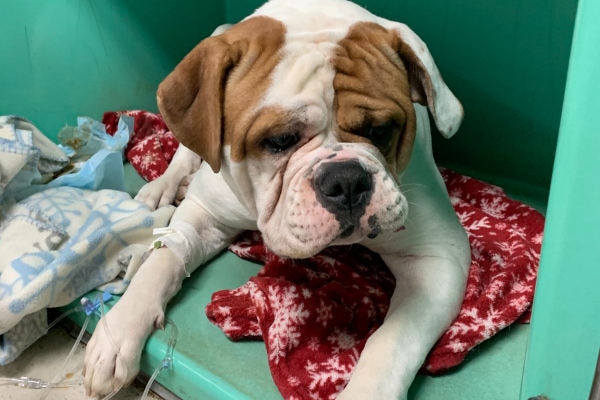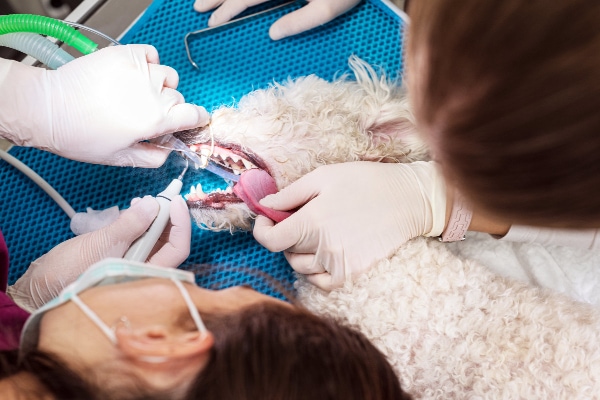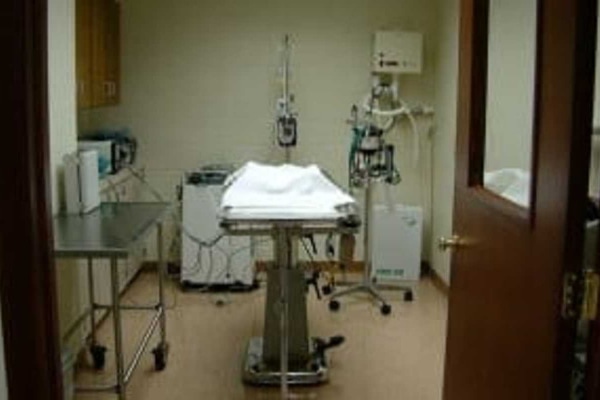Post-op monitoring: senior dog anesthesia recovery
You may be surprised to hear that the most dangerous time for anesthesia is actually the first three hours after the procedure is completed. Statistically, this is when most animals have adverse anesthetic events. Just like what happened with Teddy, animals can do great during surgery and then have life-threatening complications during recovery.

Post-operative monitoring is critical for any patient, and this is even more important in older dogs who may have more trouble with breathing and circulation. Your vet will have a plan for pre-operative testing, intra-operative monitoring, and a post-op plan as well. For more intensive procedures, he or she may recommend your dog stay overnight, or be transferred to a 24-hour facility if needed.
Avoid it: Skip elective or cosmetic procedures
Every anesthetic procedure involves a risk/benefit analysis. In older dogs, the risk is higher, so we need to make sure the benefit of what we’re trying to do is higher as well. Cosmetic or elective procedures may not be worth it.
Explore whether local anesthesia may be a possibility. Of course, for lifesaving procedures, or procedures where the quality of life improvement warrants the risk (like with Teddy’s dental), anesthesia may not be avoidable and can be under the guidance of your veterinarian.
Anesthesia for oral surgery in senior dogs
Teddy’s mom agreed that he was in a lot of pain and that the anesthesia for oral surgery was a risk worth taking. He might have been in his golden years—when many would argue anesthesia is just not worth it—but the hope of eliminating his pain made the decision obvious.
I contacted board-certified anesthesiologists before the surgery to discuss my concerns and formulate a customized anesthetic protocol based on age, lab results, and physical condition.
The dental procedure took over two hours and Teddy’s vital signs were perfect. No red flags. I worked as swiftly as I could to extract the abscessed teeth and suture the flaps of gum left behind. Meanwhile, my conscientious technician monitored Teddy’s anesthetic depth, heart rate, respiratory rate, body temperature, blood pressure, and blood oxygen levels, and we made adjustments in Teddy’s anesthesia accordingly.
She carefully recorded this data every few minutes on a chart, which she held on a clipboard, so we could monitor trends. We gave Teddy intravenous fluids before and during the procedure to maintain his blood pressure and hydration.
Finally, I tied the last suture and stood up to stretch my aching back. Despite my fatigue, I felt proud of the work I’d done. I expected this surgery would be life-changing for this dog. I knew that Teddy would have a few rough days, during which we would be aggressive with a cocktail of pain medications. But then, as he began to move into the healing phase, I truly believed he would be a different dog—acting years younger.

Major dental work for dental disease in dogs can be a fountain of youth for senior dogs. I had witnessed this transformation dozens of times. I couldn’t wait to watch him bloom.
As I wrapped up my medical notes, my technician turned off the anesthetic gas. This allowed Teddy to breathe pure oxygen from the machine as we cleaned up his mouth, which was standard procedure.
Seconds later, Teddy veered off the normal path of recovery. Instead of slowly waking up…Teddy died.
Alarm bells sounded on our anesthetic monitoring machines. He had no heart rate. No pulse. No respiratory rate. We immediately began chest compressions and breathing for him through the anesthesia machine. We had all hands on deck as we drew up drugs and pumped them into his blood stream in an attempt to restart his heart.
As the scene unfolded, my mind jumped to Teddy’s family. Here he was, dying in my care, and his family was elsewhere, going about their day, unaware of the crisis. While we worked on Teddy, my receptionist immediately got a family member on the line so I could briefly alert them that Teddy had taken a turn for the worse.
By the time they arrived, Teddy was officially gone. The grief in our office was palpable, shrouding the soul of every one of us in the building. I will never forget the reaction of Teddy’s parents, which I was dreading. They wept with us–and they extended an incredible amount of grace. They knew we did our best and they told us so.
Once again, I reached out to the same specialists who helped me strategize the anesthetic protocol we had used for Teddy. I explained the entire story and provided the data which we had charted on the clipboard.
They all arrived at the same conclusion: Teddy had most likely suffered a pulmonary embolism—a clot which blocked blood supply between the heart and lungs. We couldn’t have foreseen this. There was nothing that we could have done differently. But that didn’t change that fact that Teddy was gone, and I had been responsible for his life that afternoon.

While this situation was incredibly tragic, what happened to Teddy is not common. Studies show that approximately 99.8% of healthy dogs that are anesthetized live to tell about it.
While it’s true that age and infirmity are risk factors that make the odds less rosy, through custom-tailored anesthetic protocols and diligent monitoring of patients under anesthesia and in recovery, I believe the rewards often outweigh the risks.
Next, let’s learn some protocols that you can discuss with your veterinarian to help reduce those risks.
10 Critical Signs that Indicates Your Dog is Dying
 The word anesthesia comes from the Greek word meaning “lack of sensation.” Anesthesia is accomplished by administering drugs that depress nerve function. In general anesthesia, the patient is made unconscious for a short period of time. During this unconscious state, there is muscular relaxation and a complete loss of pain sensation.
The word anesthesia comes from the Greek word meaning “lack of sensation.” Anesthesia is accomplished by administering drugs that depress nerve function. In general anesthesia, the patient is made unconscious for a short period of time. During this unconscious state, there is muscular relaxation and a complete loss of pain sensation.
Other types of anesthesia include local anesthesia, such as numbing a localized area of skin or a tooth, and spinal anesthesia, such as an epidural block commonly used in humans during childbirth.